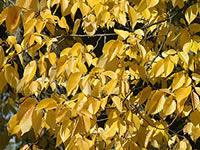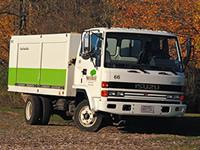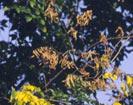Elm Trees Disease Treatment, Pruning Tips & More
The stately elm tree is a beloved American treasure. The elm tree’s large, broad canopy and interweaved drooping branches grace the streets of many towns and landscapes. The elm is a deciduous tree with large 6 inch, dark green leaves that turn yellow in the fall. In the spring the elm tree has dense clusters of small, green flowers that blossom.
The trunk of the American elm tree is gray and furrowed, whereas that of the Chinese elm tree (also known as Lace Bark elm) has a scale-like bark that is more brown in color when young, and turns to an appealing combination of crimson, green and orange when mature.

How Do You Best Grow Elm Trees?
- Elm trees grow best in rich, well-drained soil and full sun.
How Large Do Elm Trees Grow?
- Elm trees are 70-90 feet high / 40 -70 foot spread depending on species.
If you’d like to establish elm trees in your landscape, we can connect you with one of our pre-vetted landscape experts that can help you select, purchase and plant new elm trees. For a complimentary consultation with a certified arborist to discuss the elm tree varieties that would work best in your landscape contact the location nearest you.
Elm Tree Care
Unfortunately, American elm trees have battled against Dutch elm tree disease for decades, dangerously reducing the number of these marvelous trees. There are many efforts underway to develop resistant cultivars.
If you have or plant an American elm tree, regular monitoring for symptoms of Dutch elm tree disease is critical to its life. Keep these disease-prone trees as healthy as possible through regular tree pruning, watering and using elm tree fertilizer.

Newly planted elm trees will benefit from ArborKelp®, SavATree’s exclusive seaweed biostimulant which aids in tree establishment, promotes root growth and heightens stress tolerance.
Mature and established elm trees benefit from special tree fertilizer feedings of organic-based macro and micronutrients for the nutrition necessary to sustain their health.
Elm Tree Pruning
Elm trees should be trained to grow with a center leader. Tree pruning is recommended to preserve or improve the elm tree structure, vigor and life-span.
Tree pruning can reduce specific defects or structural problems in an elm tree to greatly lessen the risk of failure. Broken, diseased, or dead branches are typically removed in order to prevent decay-producing fungi from infecting other areas of the tree.

Removal of live branches from an elm tree is occasionally necessary to allow increased exposure to sunlight and circulation of air within the canopy. This assists in reduction of certain varieties of elm tree diseases. We also advocate the removal of branch stubs to promote successful and proper healing of wounds.
Your SavATree certified arborist is equipped with the latest techniques and state-of-the-art equipment to keep your elm trees healthy, beautiful and safe. Contact us today for information on tree pruning or any of our other elm tree care services.
Common Elm Tree Diseases, Pests & Signs of Tree Problems
There are several damaging diseases and pests that affect elm trees. Some of the most common are:
- Dutch Elm Tree Disease – This elm tree disease is a devastating fungus that is spread by the elm bark beetle or by root grafting. Once the fungus is established, it attacks the water conducting vessels of the elm tree, causing the tree to wilt and eventually die. Symptoms of Dutch elm disease develop quickly, within a month’s time, and include “flagging” at the crown of the tree. This means that a branch of an apparently healthy elm tree starts to wilt or its leaves start to yellow.
- Elm Bark Beetle – The elm bark beetle is the primary spreader of Dutch elm tree disease. The beetle lives in elm trees and its larvae tunnel into the tree to feed, eventually emerging as adult beetles. If a tree is already infected with Dutch elm disease, the spores of the fungus attach to the beetle. When the beetle moves to healthy elm, it brings the spores with them. One sign of elm bark beetle is red sawdust on the bark in fall or early spring.
- Spongy Moth – Spongy moth caterpillars can be found feeding on elm trees from late May until early July. These insects cause elm tree problems by defoliating the tree, making the tree weak and susceptible to other pests and diseases. Learn more about the spongy moth.

Asian Longhorned Beetle – This insect damages the sapwood beneath the bark layer, preventing the elm tree from properly transporting nutrients and water. Once a tree has an Asian longhorned beetle infestation, it will generally die within 1-2 years. Learn more about the Asian longhorned beetle.
European Elm Scale – This insect primarily feeds on American Elms and American Elm hybrids, sucking sap from the branches and leaves which often leads to chlorosis, premature leaf drop, branch dieback, or death of the entire tree. In many cases, the initial presence of this insect may go unnoticed for several growing seasons before signs and symptoms indicate a concern. Typically, this first sign of an infestation is the presence of a sticky clear substance dripping from the canopy of the tree which will begin to cover objects underneath (honeydew). When looking closer, you might also notice black sooty mold accompanied by reddish brown or gray “discs” known as mature female scales. These scales lay eggs that hatch in June and July and could be visible along the leaf veins throughout the rest of the summer months.
Don’t let these diseases or pests destroy your precious elm trees. If you suspect a problem with your trees, call a SavATree certified arborist right away for an evaluation and treatment options. Our elm tree care experts can help protect your elm trees and keep your landscape beautiful.
Diseased photo: Elm dutch elm disease 5038044 by Joseph O’Brien, USDA Forest Service, Bugwood.org
Other Common Tree Varieties in the US
- Arborvitae Trees
- Ash Trees
- Birch Trees
- Cherry Trees
- Common Persimmon Trees
- Dogwood Trees
- Elm Trees
- Japanese Maple Trees
- Leyland Cypress Trees
- Lilac Trees
- Maple Trees
- Oak Trees
- Pine Trees
- Plum Trees
- Sycamore Trees
- White Oak Trees
- Willow Trees
- Common US Tree Varieties
Contact us today to schedule a consultation with an expert arborist.